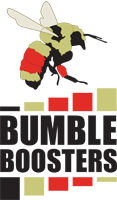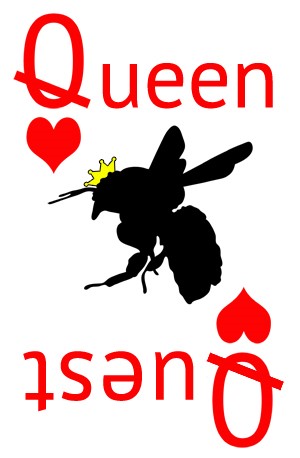Project Overview Bombicile Designs Upload Your Bombicile Data
Placing Your Bombicile The Bombicile Challenge Recommended Resources
Queen Emergence Dates
The Bumble Boosters Hay Bale Bombicile
The Bumble Boosters Hay Bale Bombicile is meant to be simple. You can purchase supplies or use what you have on hand at home. Leave the Hay Bale Bombicile in an undisturbed location for at elast 2 fall seasons. If mice nest in your bombicile, that's an ideal situation! Rodents will clear out a space in the hay bale during hte fall and winter. When they vacate the following spring, newly made cavity and neting materials may attract a newly emerged bumble bee queen. Try one out and share your findings with the Bumble Boosters community.

Schrödinger's Bombicile: the 2016 Program-sponsored Bombicile Design
The Schrödinger's Bombicile design is the 2016 Bombicile Challenge winner, created by Jeffrey and Peter of Lincoln, Nebraska.

Bombicile Design Inspiration and Relevance to Bumble Bee Biology: The existing box fused with more organic elements to entice habitation.
Design Logic: The design utilizes the 2014 Domicile Design but incorporates natural elements. The inside of the wooden box is coated in mud with bits of grass to keep the domicile cool and smelling organic. A wire cylinder is inside the box, also coated with mud, to give the bumble bees something on which to build and attach. A plastic bag surrounding the domicile keeps moisture out.
Dimensions of Bombicile: Same dimensions as the 2014 design (10' in length, 5.5' in height, 5.5' in width.
Overall Cost: Less than $20: $15 for materials for the original box and $5 for additional materials (wire, plastic bag).
Assembly Instructions: Two large flat rocks for floor and ceiling. Use smaller stones for side walls. Side walls should be approximately 10 inches high. Place one large flat rock for the floor. Mix mortar and use it to secure smaller stones comprising side, front and back walls, leaving center hollow. Level mortar on top row. Note: Make two holes thumb–size in the mortar in the front and rear walls. Fill interior with bedding approximately half way, using native straw, cotton balls, grasses, etc. Place the other large flat rock without mortar on top to make the roof.
Parts List: 1 domicile fitting 2014 design, minus the kapok fibers, mud, wire screen, heavy duty plastic bag, wire, grass, seeds, 8" tube (not necessarily PVC) with interior coated in mud
Bombicile Placement: Buried or left in shade. Either near flowers for inviting access, or away from flowers for comforting seclusion.
The Bumblestone: the 2015 Program-sponsored Bombicile Design
The Bumblestone is the 2015 Bombicile Challenge winner, created by Robert in New York.
Bombicile Design Inspiration: We were involved in the project last year. We placed our domicile near a protected hedge, but got no residents. We noticed that bumble bees were nesting in the stone wall of our front patio.
Relevance to Bumble Bee Biology: Bumble bees seemed to be drawn to the stone wall and the small holes that were in the mortar.
Design Logic: The design replicates the habitat which attracted them naturally.
Dimensions of Bombicile: 12' in length, 10' in height, 10' in width.
Overall Cost: The price of one small bag of mortar. Other materials can be found naturally.
Assembly Instructions: Two large flat rocks for floor and ceiling. Use smaller stones for side walls. Side walls should be approximately 10 inches high. Place one large flat rock for the floor. Mix mortar and use it to secure smaller stones comprising side, front and back walls, leaving center hollow. Level mortar on top row. Note: Make two holes thumb–size in the mortar in the front and rear walls. Fill interior with bedding approximately half way, using native straw, cotton balls, grasses, etc. Place the other large flat rock without mortar on top to make the roof.
Parts List: 1 small bag of mortar, 2 large flat rocks, small rocks as needed to build up walls 10 inches high.
Bombicile Placement: Protected garden site.
Just a Board: Honorable Mention, 2015 Bombicile Challenge Submission
Bombicile Design Inspiration: Many years ago I tried to kill off some unwanted plant by placing a 2'x3' piece of scrap plywood over it. Voles & mice made their homes under the board, and later, bumble bees.
Relevance to Bumble Bee Biology: My bees seem to like protected places right at ground level.
Design Logic: There is no design - it is a board :-). I have also used 12"x12" slate tiles.
Dimensions of Bombicile: 12"x12" to 48"x48".
Overall Cost: The price of one small bag of mortar. Other materials can be found naturally.
Assembly Instructions: 1. Buy board. 2. Cut it. Or not. Make sure it is at least 12"x12".
Parts List: 12"x12" or larger board/plywood/slate tile
Bombicile Placement: It works best of the ground is a bit uneven, so that there are gaps at the edge of the board. Also it is good to be near (or on) clumps of grass. The voles, mice, and bees seem to prefer being in/near grass or other short vegetation. It is important to leave the board in place for a long time (years). A regular sheet of plywood will last about 8 years in my climate - Cascadia. Slate will probably last decades. I would stay away from treated wood. There is no need to place anything under the board, the voles & mice will move whatever they want under the board, and later the bees will use these materials. After about a year the surface of the board will be covered with mosses etc. so it won't look bad. It is OK to walk on the board occasionally, until it starts to rot. But it is probably best to put it somewhere that does not get a lot of foot traffic.
Plastic Container Domicile: Honorable Mention, 2015 Bombicile Challenge Submission
Bombicile Design Inspiration: To create interest in pollinator research; To experiment and discover bumblebee acceptance of a variety of non-conventional design ideas to increase the domicile nest habitation rate.
Relevance to Bumble Bee Biology: This domicile can be adapted to the needs of various varieties of bumblebees that use habitats in trees, woodlands, grasslands, above or below ground.
Design Logic: Simple design, ease of construction, low cost, use of readily available materials around the home, ability to place in trees, structures, on or in the ground, in grasslands or woodlands. Additional ideas can be incorporated for variety to test bumblebee acceptance.
Dimensions of Bombicile: 10 inches long, 7 inches wide, 7 inches high.
Overall Cost: Minimal cost, near $0. Use common home materials.
Assembly Instructions: 1. Drill a few small holes in lower half of container for aeration and drainage. Can cover holes with screen to keep out other intruders. 2. Fill container with 1quart gravel, sand, dirt for stability, lay container on side, handle down. Insert nesting material in opening spreading completely around inside of container, leaving opening in the center for the nest. Add 1 1/4 in. hose into opening for entrance. Can paint end of entrance hose to aid in bumblebees locating the opening. Can add a 2nd rear opening by making another hole in the back and adding another piece of hose. After being placed in field, a cover can be placed on top for protection from weather, sun, etc.
Parts List: One gallon plastic container, 1-2 feet hose for entrance, 1quart fill material, gravel, sand, dirt. Nest insulating material such as, kapok, cotton, dried grass, clippings, dry leaves, etc, small pieces of window screen about 1 inch square to cover vent holes. Can also add a rear entrance in back of container by simply drilling a hole and inserting another piece of 1 1/4 in. hose. Tape or paint to color hose entrance.
Bombicile Placement: Various options - in trees, other structures, on ground surface or buried in ground. Can be placed in grass land or wooded areas.










